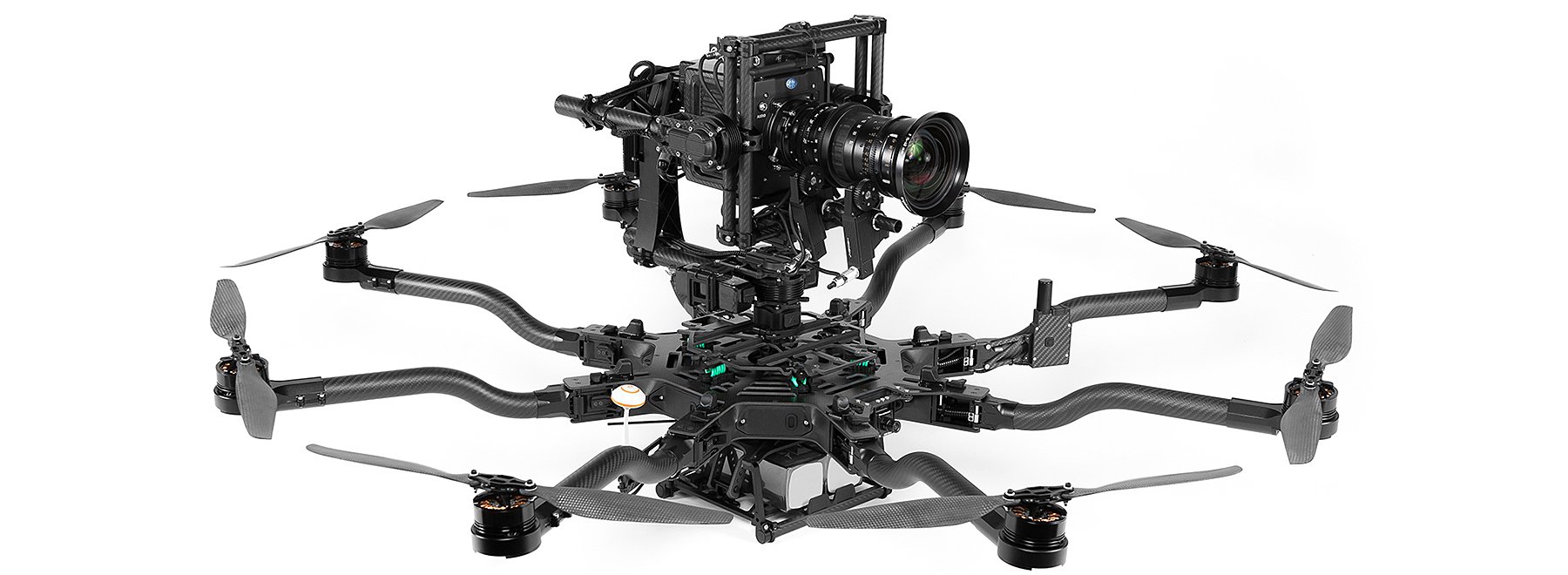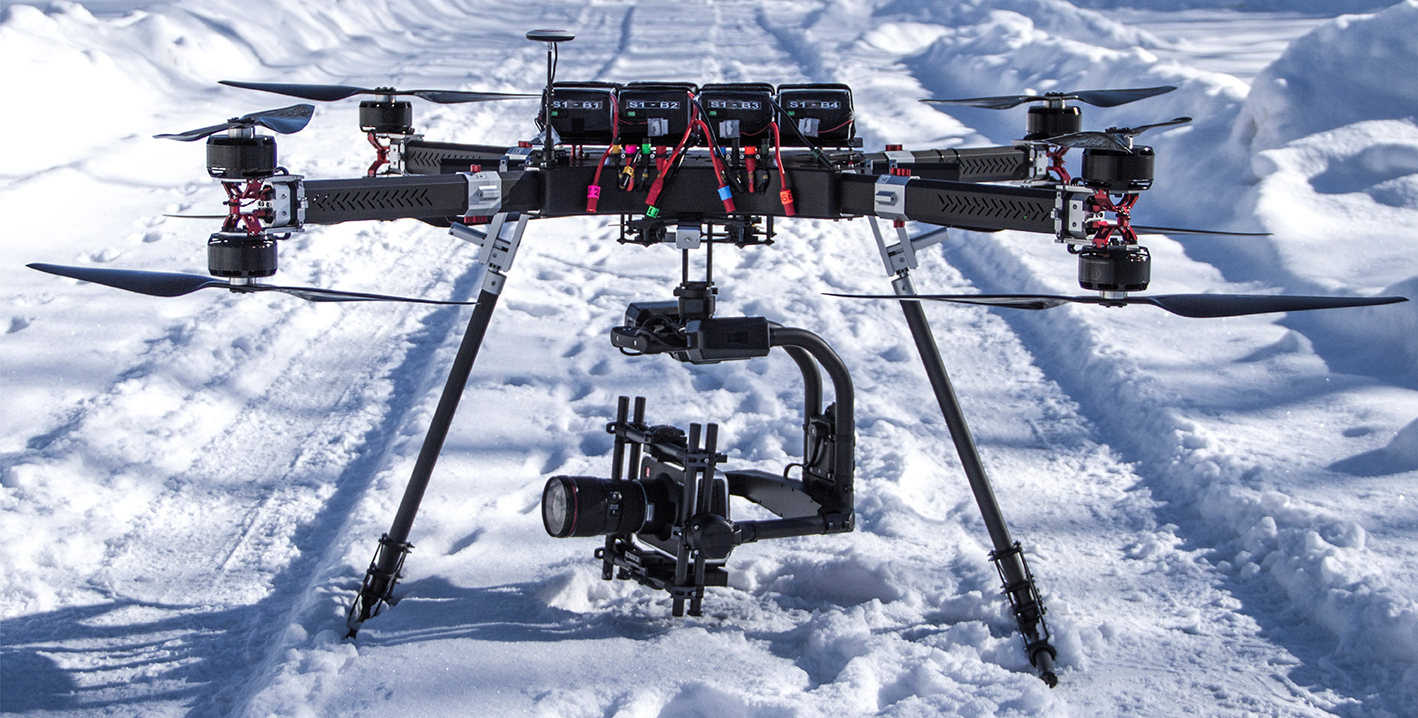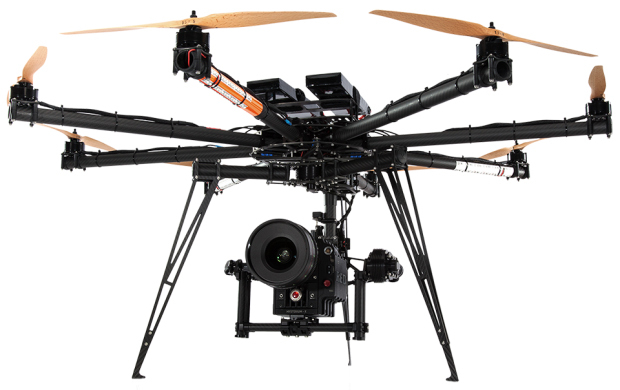
Drone Focus: Heavy Lifters
The sky’s the limit with the jumbo-sized UAVs from companies such as Freefly Systems and Gryphon Dynamics. (Part 3 of 3)
If you think drones are just a toy, you haven’t been paying attention. “Heavy-lifters” capable of flying Reds, Alexa Minis, Canon EOS 5Ds and even Sony FS7s are becoming more ubiquitous by the day. While high-and-wide establishing shots are their bread and butter, UAVs (unmanned aerial vehicles) are increasingly allowed to speak their own unique cinematic language.

Take some of the car commercial shots by Aerial Edge pilot Nick Kolias. In one, “we start a few hundred feet over a tree canopy, then descend rapidly at a strategic angle through small gaps in the trees, all while keeping the picture car in frame and leading it just the right distance. We’ve done that with the Red Weapon/Zeiss Super Speeds and a [Freefly Systems] Cinestar 8HL, as well as an Arri Alexa Mini/Zeiss Super Speeds and an [Freefly Systems] Alta 8 drone,” he says. “Another interesting set-up was flying through the urban canyons and alleyways of the San Francisco financial district, chasing cars for Lexus. In that case, we had an Alexa Mini/Leica Summicron on an Alta 8. We were right in between high-rise buildings at around the 10th floor, looking down at the streets below. The common denominator with these is that the locations were very tight, much too small for a full-size helicopter, yet we could safely get the drone in there and capture amazing footage.”
Enormous strides have been taken in a very short time. Just seven years ago, before multirotor drones became the norm, Tabb Firchau was tinkering with single-rotor RC helicopters and chasing the Holy Grail: a stable, vibration-free gimbal for smooth aerial cinematography. He cofounded Freefly Systems in 2011 and within a couple of years came up with the MōVI, the first commercial-grade brushless gimbal. (Through designed for aircraft, the MōVI quickly gained fame as a handheld rig.)

But first, Freefly launched the CineStar. “It was essentially an airframe kit that some of the early grassroots aerial guys were using to build up their own heavy lifter,” says Freefly Tech Support staffer Adam Henley. “We did have an early servo-driven gimbal that stabilized on two and three axes, but it was slower technology; it couldn’t do that instantaneous response to bumps and twists and rolls that the new brushless technology can.”
Many iterations followed, then in 2015 Freefly unveiled the ready-to-fly Alta 6, followed the next year by the Alta 8. Quick to prep and eminently portable, these are the leaders in dual-operator heavy lifters in the U.S. today.
The term “heavy lifter” isn’t officially defined, but is generally taken to mean drones that can carry professional-grade cameras with cinema lenses, as opposed to GoPros or other compact action cameras. Weight-wise, some define it as anything over 40 lbs total, including drone, payload, and batteries. The FAA limit is 55 lbs; heavier set-ups require a waiver.
The Alta 8 measures 1325mm without props and has a payload rating at sea level of 20 lbs and a maximum takeoff weight of 18kg/40 lbs. As such, it can handle a variety of camera/lens combos. (The kit includes a hanging scale, to simplify the calculation.) Henley is seeing a lot of mirrorless cameras these days, such as the Sony Alpha A7s and A7r, as well as the Canon EOS 5D line. Among bigger cameras, the Red and Alexa Mini are most popular. While wide primes are the norm, zooms and longer focal lengths are making inroads, thanks to improvements in the stabilization of gimbals like the MōVI Pro. “And now that there’s RCT connectivity, users can change settings like ISO and shutter over radio control, which is fantastic,” Henley says. “The benefit is to save time; you can make a quick change in the air, instead of landing and changing batteries and all that.”
Those features have allowed the Alta to gain favor among filmmakers. “They speaks to the company’s creative roots,” Henley notes. “We design products we want to use. We understand the pressures and challenges of traveling with professional-grade equipment. Being able to show up and not spend an hour plugging in wiring, winding things, tweaking the set-up, and hoping you got it right is huge.”
The Alta’s 18" props fold up, as do its swan-neck booms. That little bundle — 50 percent of the Alta 8’s operating size, 33 percent of the Alta 6’s — fits into a single custom Pelican case. (One of Freefly’s promotional videos shows it being unloaded, then strapped to a backpack and walked deep into the woods.) Once on location, the drone can be unfolded and ready to fly in five minutes. A feature that makes that possible is the popular Toad in the Hole quick-release unit, created for the MōVI but widely adaptable. Positioned at top and bottom of the drone, it allows the gimbal to be easily popped out, then hand-carried or mounted to any other rig having the Toad system.
Another key feature: Freefly was the first multirotor manufacturer to offer top-mount for cameras, which they’ve dubbed SkyView (seen at top of this page). “It definitely creates unique opportunities, not just for cinema, but inspection companies like it for looking up under a bridge,” says Henley. “For creative shots, it’s pretty unparalleled.”
Like every RT aircraft, the Alta offers different flight modes, each with its own advantages. For standard operations, there are Manual, Height Hold Mode, and Position Mode. Manual is the default mode, used for take-off and landing. It offers full-throttle authority for fast, powerful climbs. Manual also auto-stabilizes the drone, keeping it level, but without holding position if there’s wind.
Height Hold is essentially like having an air-borne dolly. It automatically controls altitude using barometric and motion sensors. (Since GPS isn’t necessary, this mode can be used indoors.) The result is smooth, flowing shots. Henley likens it to a hockey puck: “If you give it a little push, it’s just going to glide.”
Position Hold adds another layer of automation, allowing the pilot to maintain geospatial position over the ground, even when there’s a breeze. It can also be set to track along with your subject, matching pace. “We’ve flown over a kayaker,” says Henley. “The flow rate of a stream is pretty consistent. In Position Mode, you can match the speed of that subject and take that workload off the pilot. Normally you’re going, ‘I’m too fast! I’m too slow!’ and are trying to find that balance. It can really make that easy to do and get the shot in one take.”
This year, there’s a new kid on the block: Gryphon Dynamics. Founded in 2012, the company is almost as old as Freefly, but it’s based in South Korean and is only now making a concerted push into the U.S. market with a new line of ready-made heavy lifters. The company got its start making electronic components for remote vehicles, then moved into carbon fiber and aluminum manufacturing. All the while, the CEO was pursuing a serious RC helicopter habit. It spiraled from there.
Spearheading Gryphon’s launch in North America is Max Tubwell, formerly of Steam Machine Aerial. “I started using their equipment in 2013, as a customer. It was kind of hard to get,” he says. “You had to buy individual parts, and it was hard to assemble. What’s happening now is, I’m heading this move to make a new product line that’s ready to fly.” The manufacturing base will be in Philadelphia; distributors and a new website are currently being set up.
The ready-made product line springs from their most popular custom builds (which will still be available). All have two motors and propellers per arm. Compared to other heavy lifters, “The frames are stronger, meant for a heavier weight class and harsher environments,” says Tubman. The company uses its own carbon fiber, naturally, and designed the boom arms with a relatively unique octagonal shape, which is stronger than round, according to Tubman. “So we can have really powerful motors without having the arms be thick and heavy,” he says. “Our systems also use a higher voltage system, which allows you to spin larger propellers, which are more efficient.” Their prop size ranges from 16" to 30".
Unlike the Alta, the props are removable and switchable, with different models meant for different weather conditions or flight needs (e.g., power versus efficiency/endurance). “If it’s not that windy, or if it’s going to be a long take, we can put on arms that would give us 25-minute flight time with a 20 lb payload”—more than double the competition, Tubman claims. Modular props also make it easy to bring back-ups. Gryphon aircraft can be packed into one or two Pelican cases, depending on the model.
The new line starts with the smaller GD-18X, which measures 1000mm from motor to motor. It sports 16" to 18" props and has a maximum takeoff weight of 25kg/55 lbs. It’s a popular match for cameras in the 5 to 15 lb range, and has been used by the CBS series Madam Secretary, Jaguar and Land Rover, to name a few, as well as the recent feature Fate of the Furious, which flew a custom version. “It’s pretty fast and very nimble. You have a lot of punch in a fairly small package,” says Tubman.
There are also two plus-size drones: GD-28X and GD-40X. Both measure 1400mm, take 26" and 30" props, and use a higher voltage 44v system. Their maximum take-off weight is 28kg/62lbs and 40kg/88lbs respectively—powerhouses that, loaded to capacity, would require a waiver to the FAA’s 55lb limit. But they can fly lighter payloads too, and without strain. “A lot of times, you have a drone that’s meant for 45 or 55 pounds, and it’s working very hard to stay up in the air. As you get bigger and go to higher voltage systems, the drone operates much nicer,” Tubman observes. “There’s less stress on the electronics and the motors, and it can handle heavier winds. You’re not fighting physics so much. It’s like when you have to move X amount of payload with your pick-up truck and it’s really struggling to get up the hill, or you can use a box truck, which is meant for lifting those payloads. Both will do it, but one will do it with a lot more ease.”
Like Henley, Tubman is seeing a growing sophistication in the types of shots drones are being asked to perform. “We’re in this transitional period right now,” he says. “We’re just scratching the surface of what’s possible. When they’re starting out, a lot of people will do high and wide. But pros are doing much lower, closer, dynamic shots, where it’s high-speed, low altitude, and close proximity.”
All agree that safety is paramount. “As drones become more common on set, it’s important to stay vigilant and avoid a complacent attitude,” says Aerial Edge’s Kolias. “The equipment we use, our maintenance regimen, our flight testing and verification, the pre-flight checks and status monitoring are all intended to ensure the safest drone operations possible.” For Kolias, knowing that drones have advanced from their scratch-built phase to proven, reliable, industrial-grade aircraft manufactured by companies like Freefly and Gryphon makes all the difference. “I literally sleep better at night because of that.”
For more in our Drone Focus series, see:






